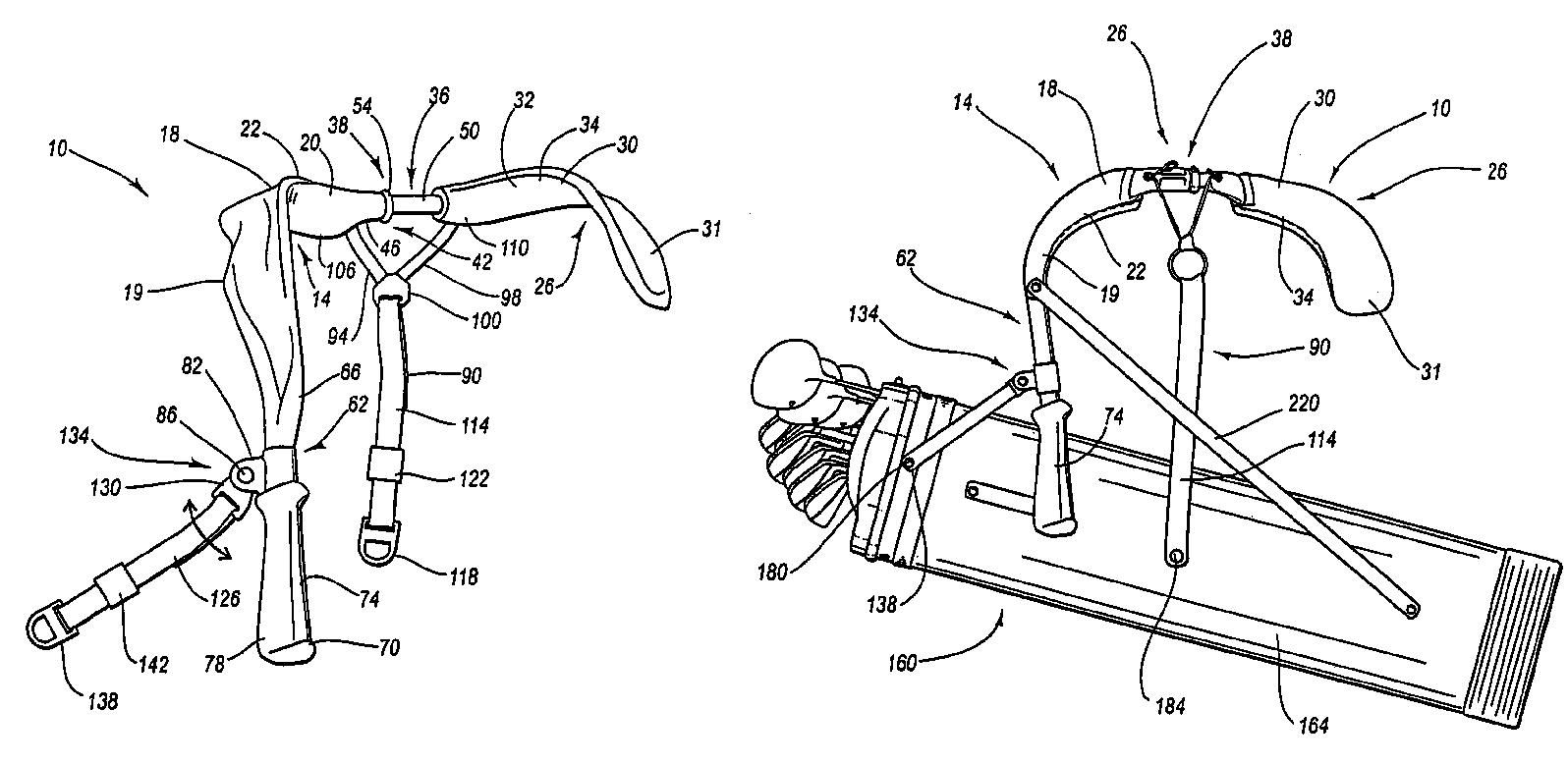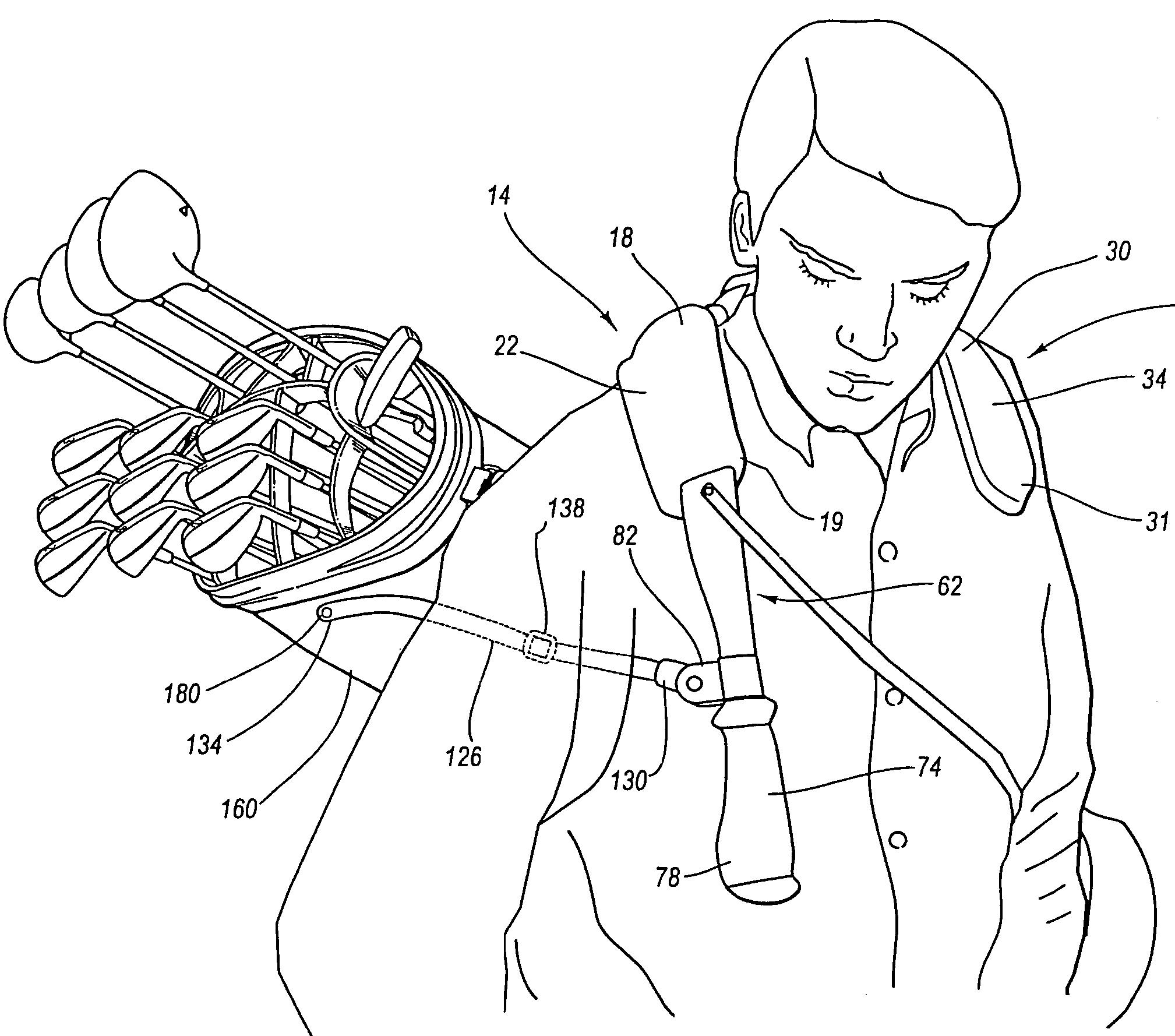Ever Struggle to Get the Second Strap of Your Carry Bag Over Your Shoulder (of course you do, who doesn’t)? Well an Ogio Golf Bag Invention may be the Solution
Familiar with that fish out of water feeling when trying to get your left arm through that second carry strap? (and how it typically occurs when a cute beer cart girl is driving past) Well, Ogio recently received a patent on a device that may eliminate the fish out of water feeling and the odd glances of passersby as it appears that you are practicing your swimming stroke or swinging at flies.
The patent is USPN 7559443 titled “Carrying Device for a Cartable Item Providing Single to Dual-Shoulder Support Transitioning” and stems from an application that was filed way back in 2002. The patent describes the invention as:
The present invention features a unique carrying device for carrying a cartable item, wherein the carrying device is formed of a rigid structure and comprises means for engaging a first shoulder of a user, means for engaging a second shoulder of a user, means for connecting the means for engaging the first and second shoulders of a user together, means for adjusting the ergonomic configuration of the carrying device, means for releasably coupling or attaching the carrying device to a golf bag, and means for transitioning, upon elective actuation, functions to transition or convert the carrying device from a single-shoulder carrying arrangement or position to a dual-shoulder carrying arrangement or position.
Check out this design.


The patent explains:
1. Field of the Invention
The present invention relates to carrying devices, such as harnesses or straps, designed to attach to or be integrated with containers, backpacks, luggage, bags (e.g., golf bags, mail bags, etc.), and basically any and all cartable items of various sorts, that allow the user to carry and support the cartable item over one or more shoulders using the carrying device. Particularly, the present invention relates to a unique carrying device and system designed to allow a user to initially carry and support a cartable item on a single shoulder, with the added ability to quickly and effortlessly transition the carrying device so that dual-shoulder carrying support of the cartable item is achieved. The present invention also relates to a method of transitioning the carrying device from a single-shoulder carrying support position to a dual-shoulder carrying support position.
2. Background of the Invention and Related Art
Carrying devices, such as harnesses or straps, are commonly found and utilized in everyday situations to support the carrying of cartable items, such as backpacks, golf bags, mail bags, luggage, and a host of others via the shoulder(s) of a user. Many of these prior art carrying items are designed to engage one or more shoulders of the user without offering the choice of one or the other. Moreover, many of these prior art carrying devices are made of soft, flexible materials that tend to cause unnecessary strain and tension on the user.
In particular, such carrying devices are commonly found in the golfing arena. The game of golf is one of the most widely enjoyed sports activities in the world and has strong support at both the recreational level as well as the professional level. While golf has always been an enjoyable game for both novices and professionals, the popularity of the game has exploded in recent years. Record numbers are flocking to beautiful courses worldwide to try their hand at the seemingly arduous task of putting a little white ball in a four inch hole located hundreds of yards away in as few shots as possible. Along with the exploding popularity and record numbers of players, golf equipment has also seen changes. Particularly, as the game of golf requires several different clubs, balls, tees, and other accessories to even play the game, a golf bag has become an indispensable part of any golfer’s inventory.
During play, golfers typically travel over a course in one of several ways. For example, a golfer may walk a course and carry his/her clubs, or sometimes employ a caddy to carry the clubs for him/her. Other golfers utilize wheeled pull carts, or motorized or engine driven carts where the golf clubs in a golf bag are mounted to the cart, typically near the rear. Of particular interest herein is those persons who walk a golf course and carry a set of clubs. The present invention is thus useful for a substantial number of golfers who desire walking a golf course as a means of healthy, enjoyable exercise.
One of the drawbacks which has long existed for these golfers is the nature of the construction of the standard golf bag. Traditionally, golf bags have been designed and manufactured having very simple carrying systems with the only thought to provide means by which the golfer could carry the golf bag, which housed both clubs and balls. Here, the typical golf bag used to receive the set of clubs was in the form of a tubular carrying member enclosed at one end so that the shafts of the clubs could be longitudinally received in the bag. Moreover, the traditional carrying systems or devices employed to carry these golf bags consist of a single strap that extends from an upper rim of the golf bag to a mid-point on the bag. The strap is preferably loose and made of flexible material, wherein the golfer or the caddy is able to carry the golf bag by inserting one arm through the strap so that the strap extends across one shoulder, thus supporting the bag for travel. The golf bag resultantly hangs down in a natural resting position depending upon the location and slack in the strap. Although simple in design, this single-strap design has endured through the years and is still very popular today, especially on lower priced golf bags.
Although popular, several disadvantages and deficiencies are present in this design that are readily recognized by those individuals who carry such golf bags over a golf course. One such problem results from the fact that the entire weight of the golf clubs and bag, which may typically be on the order of twenty to thirty pounds, tires the shoulder of the user, especially when several rounds are being played. Such fatigue, due to the weighty nature of the golf bag, potentiates strain of the muscles of the neck, shoulders, and back, which is further perpetuated by the often imbalanced nature of the golf bag relative to the user. For instance, the weight, imbalance, and single strap design can cause associated muscle soreness in the hips and lower back due to the fact that the center of gravity of the bag is offset with respect to the spine of the user. This is of particular concern to those golfers who experience back problems. Another problem associated with the single strap design is the annoying swing or rocking of the golf bag that repeatedly pounds the user over and over as he/she walks from hole to hole. This constant swinging or rocking motion is derived from and is in tune with the natural walking frequency of the user and is difficult to stabilize.
There is little doubt that Ogio comes up with some pretty cool products!
Dave Dawsey – Watching Golf Bag Patents
PS – click HERE to check out other golf club IP posts
